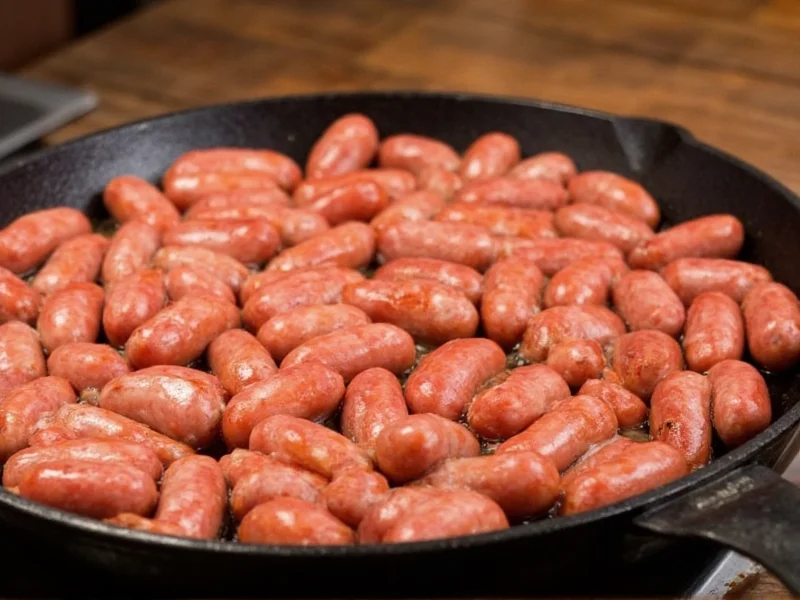Knowing how can you tell if sausage is cooked properly is essential for both food safety and optimal flavor. Undercooked sausage poses serious health risks from bacteria like Salmonella and E. coli, while overcooked sausage becomes dry and unappetizing. This comprehensive guide provides science-backed methods to accurately determine sausage doneness across various cooking methods.
Why Proper Sausage Cooking Temperature Matters
Food safety should always be your primary concern when cooking sausages. Raw meat products harbor potentially harmful bacteria that only proper cooking temperatures can eliminate. The USDA recommends specific internal temperatures to ensure pathogens are destroyed while preserving moisture and texture. Understanding what temperature should cooked sausage be prevents both foodborne illness and culinary disappointment.
The Gold Standard: Meat Thermometer Verification
No method beats a digital meat thermometer for accuracy when determining how to know when sausage is fully cooked. Here's the definitive temperature guide:
| Sausage Type | Safe Internal Temperature | Visual Indicators |
|---|---|---|
| Pork & Beef Sausages | 160°F (71°C) | No pink color, firm texture |
| Chicken & Turkey Sausages | 165°F (74°C) | White or tan color throughout |
| Pre-cooked Smoked Sausages | 140°F (60°C) | Heated through, slightly firm |
Insert the thermometer into the thickest part of the sausage, avoiding contact with the cooking surface. Wait 15 seconds for an accurate reading. Remember that is sausage cooked when no longer pink isn't always reliable—some sausages contain nitrites that preserve pink color even when fully cooked.
Supplementary Visual and Textural Indicators
While thermometer use is essential, these secondary signs help confirm proper cooking:
- Texture test: Properly cooked sausage feels firm but slightly springy when pressed. Undercooked sausage remains soft and squishy.
- Juice color: Cut into the thickest sausage—clear juices indicate doneness, while pink or red juices mean more cooking time is needed.
- Skin appearance: Well-cooked sausage develops a golden-brown exterior with slight crispness, but color alone shouldn't determine doneness.
- Time guidelines: As a general reference (but never substitute for thermometer verification), 25-30 minutes for 1-inch diameter sausages at 350°F oven temperature.
Common Mistakes When Checking Sausage Doneness
Avoid these frequent errors when determining how to avoid undercooked sausage:
- Guessing by color alone: Many sausages maintain pink hues due to curing agents even when safe to eat.
- Pressing too frequently: Repeatedly squeezing sausages causes precious juices to escape, resulting in dry meat.
- Testing too early: Checking temperature before sausages have cooked sufficiently gives false low readings.
- Ignoring carryover cooking: Sausages continue cooking 5-10°F after removal from heat—remove them just below target temperature.
Cooking Method Considerations
Different cooking techniques require specific approaches for determining signs of properly cooked sausage:
Grilling
Rotate sausages regularly to prevent burning while ensuring even cooking. Use indirect heat for thicker sausages to prevent exterior charring before interior reaches safe temperature. The best way to check sausage doneness on grill remains thermometer verification.
Pan-Frying
Cook over medium heat to avoid burnt exteriors with raw interiors. Add 1/4 inch of water after initial browning and cover to steam-cook through, then remove lid to crisp exterior. Check temperature before removing from heat.
Baking
Oven cooking provides the most even heat distribution. For accurate sausage internal temperature guide readings, rotate baking sheet halfway through cooking time to address oven hot spots.
Food Safety Essentials
Never rely solely on how long to cook sausages for safety time estimates. Variables like sausage thickness, starting temperature, and cooking equipment significantly impact actual cooking time. Always use a thermometer, especially with poultry sausages which require higher temperatures than pork varieties.
Store leftovers within two hours of cooking and consume within three to four days. When reheating, ensure sausages reach 165°F (74°C) again for safety.
Troubleshooting Common Issues
Problem: Sausage casing splitting during cooking
Solution: Prick casings with a fork before cooking to release steam, or cook at lower temperature.
Problem: Exterior browning too quickly while interior remains raw
Solution: Start with lower heat, or partially cook in simmering water before finishing with browning.
Problem: Sausage remains pink after reaching safe temperature
Solution: This is normal with cured sausages—trust your thermometer over visual cues for can you tell if sausage is cooked by color determinations.











 浙公网安备
33010002000092号
浙公网安备
33010002000092号 浙B2-20120091-4
浙B2-20120091-4